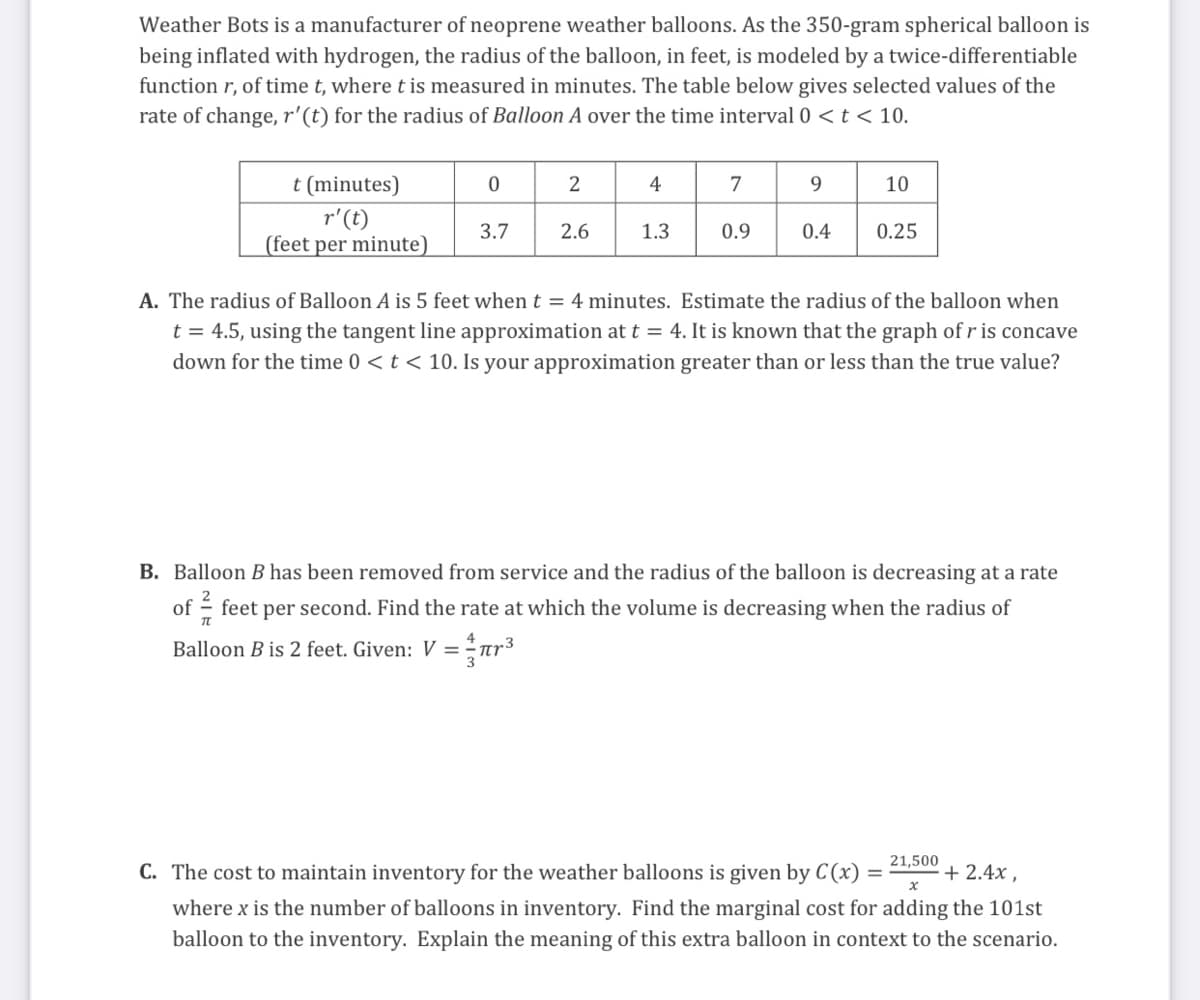Weather Bots is a manufacturer of neoprene weather balloons. As the 350-gram spherical balloon is being inflated with hydrogen, the radius of the balloon, in feet, is modeled by a twice-differentiable function r, of time t, where t is measured in minutes. The table below gives selected values of the rate of change, r'(t) for the radius of Balloon A over the time interval 0 < t < 10. t (minutes) 4 7 10 r'(t) (feet per minute) 3.7 2.6 1.3 0.9 0.4 0.25 A. The radius of Balloon A is 5 feet when t = 4 minutes. Estimate the radius of the balloon when t = 4.5, using the tangent line approximation at t = 4. It is known that the graph of r is concave down for the time 0
Weather Bots is a manufacturer of neoprene weather balloons. As the 350-gram spherical balloon is being inflated with hydrogen, the radius of the balloon, in feet, is modeled by a twice-differentiable function r, of time t, where t is measured in minutes. The table below gives selected values of the rate of change, r'(t) for the radius of Balloon A over the time interval 0 < t < 10. t (minutes) 4 7 10 r'(t) (feet per minute) 3.7 2.6 1.3 0.9 0.4 0.25 A. The radius of Balloon A is 5 feet when t = 4 minutes. Estimate the radius of the balloon when t = 4.5, using the tangent line approximation at t = 4. It is known that the graph of r is concave down for the time 0
Trigonometry (MindTap Course List)
10th Edition
ISBN:9781337278461
Author:Ron Larson
Publisher:Ron Larson
Chapter6: Topics In Analytic Geometry
Section: Chapter Questions
Problem 33CT
Related questions
Topic Video
Question
Please help with this three part question. Or at least part A

Transcribed Image Text:Weather Bots is a manufacturer of neoprene weather balloons. As the 350-gram spherical balloon is
being inflated with hydrogen, the radius of the balloon, in feet, is modeled by a twice-differentiable
function r, of time t, where t is measured in minutes. The table below gives selected values of the
rate of change, r'(t) for the radius of Balloon A over the time interval 0 <t < 10.
t (minutes)
4
7
9
10
r'(t)
(feet per minute)
3.7
2.6
1.3
0.9
0.4
0.25
A. The radius of Balloon A is 5 feet when t = 4 minutes. Estimate the radius of the balloon when
t = 4.5, using the tangent line approximation att = 4. It is known that the graph of r is concave
down for the time 0 < t < 10. Is your approximation greater than or less than the true value?
B. Balloon B has been removed from service and the radius of the balloon is decreasing at a rate
of - feet per second. Find the rate at which the volume is decreasing when the radius of
Balloon B is 2 feet. Given: V = ar3
%3D
21,500
C. The cost to maintain inventory for the weather balloons is given by C(x) =
+ 2.4x ,
where x is the number of balloons in inventory. Find the marginal cost for adding the 101st
balloon to the inventory. Explain the meaning of this extra balloon in context to the scenario.
Expert Solution
This question has been solved!
Explore an expertly crafted, step-by-step solution for a thorough understanding of key concepts.
This is a popular solution!
Trending now
This is a popular solution!
Step by step
Solved in 3 steps

Knowledge Booster
Learn more about
Need a deep-dive on the concept behind this application? Look no further. Learn more about this topic, advanced-math and related others by exploring similar questions and additional content below.Recommended textbooks for you

Trigonometry (MindTap Course List)
Trigonometry
ISBN:
9781337278461
Author:
Ron Larson
Publisher:
Cengage Learning


Trigonometry (MindTap Course List)
Trigonometry
ISBN:
9781337278461
Author:
Ron Larson
Publisher:
Cengage Learning
